The Northrop F-5 Enthusiast Page - Home
قوات
الجوية المكية الأردنية - Al Quwwat al-Jawwiya Almalakiya al-Urduniya
Royal Jordanian Air Force
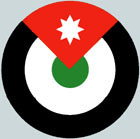
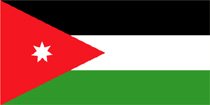 Credit:
Roundels of the world
Credit:
Roundels of the world
Last update 26-02-2022
A discussion was kept at Washington on 08-02-66 regarding
an Israeli request for Grumman A-6 Intruder. To keep the military
balance in the Middle East and to convince King Hussein not to purchase
Soviet military
equipment it was considered to offer either 36
second-hand F-104A/B or Northrop F-5 Freedom Fighters in increments of
12 per year, to be delivered starting from 1968. Neither the Intruders
nor the Freedom Fighters
were at the end delivered.

The US
goverment agreed bwginning of 1973 to the transfer of Freedom Fighter from
Iran to Jordan; pilots training started late 1973 at Williams AFB (USA) in view of the
arrival of the first 20 F-5A and 4 F-5B (total only 22 according to the Air Force page), received in December 1974.
They were
used in pool by No.1 and No.2 Squadron at
King Hussein AB (Mafraq)replacing
Hawker Hunters; 31 of these last were transferred to the Royal Air
Force of Oman between March 1975 and 1976. In addition, an
order for 2 new-build F-5B (under the Peace Oasis programm) was placed
with Northrop during Fiscal Year 1973, due to the increased fighter pilots training necessity.
Iran requested, and was granted, US authorisation
to transfer 10 additional F-5As and 2 F-5Bs in September 1975, bringing the Squadrons to full strength.

Northrop F-5A serial 218; its camouflage shows clearly its Iranian origin.
Upgrading to the Royal Jordanian Air Force equipment was planned
contemporaneously to the receipt of the Iranian aircrafts.
Request was made for the supply of McDonnell F-4 Phantom for the value
of USD 50m, but this was refused by the USA government. An agreement in
principle was reached during a visit of King Hussein to Washington
in February 1973 to
supply Jordan, within the US Military Assistance Pact, with 22 next
generation Northrop F-5E and 2 F-5F Tigers, scheduled to be
delivered
by November 1975, for both for air defence and
air-to-ground attack.
A
possible swap of 20 Jordanian Northrop F-5As against Moroccan bought
Northrop F-5E considered in 1976 took not place, the aircraft were kept in local service. The US government also
refused in 1976 to transfer
former South Vietnamese Tigers to Jordan in order to increase and speed up delivery.
A further 6
Northrop F-5B (progamm Peace Sand) were also to be added to improve
training capacity, order later cancelled.
Air-to-air missiles, in the form of AIM-9J, were
received, replaced from 1983 by AIM-9P-3 and AIM-9P-4. A
request for Maverick air-to-ground missiles and laser-guided bombs was
blocked in 1978.
Personnel
was sent to Williams AFB to undergo training with USAF's 425
Fighter Squadron and an USAF Mobile Training Team came to Jordan for
conversion of pilots locally; instructors continued to be trained at
Williams AFB till the end of
the 80s.
First F-5E was handed over by
Northrop on 30-04-75, delivery (on board of Lochkeed C-5 Galaxy
in 8-pack) of an initial batch of 40 or 44
(according to the source) F-5E and 2 F-5F started in May 1975 and ended by
July 1977. First F-5E local flight was from
Prince Hassan AB on 10-05-75.
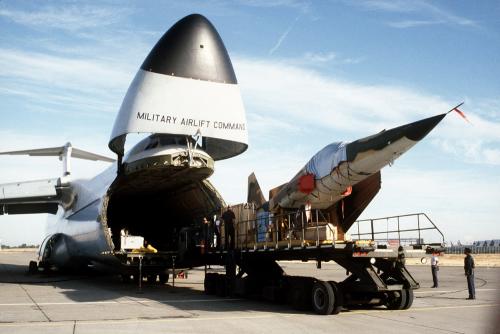 Photo: USAF
Photo: USAF 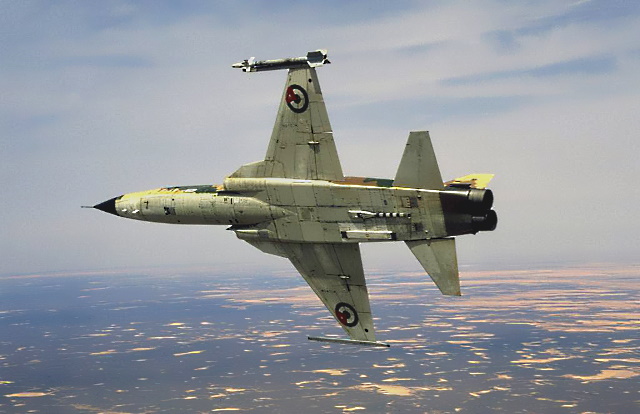
Delivery of a camouflaged Nothrop F-5E by a Douglas C-5A.
In-flight view of a
Northrop F-5E with AIM-9 Sidewinder Photo: unknown
The Royal
Jordanian AF received from the USA a total of 61 single-seaters divided in
several orders (22 in Fiscal
Year 1974, 18 in FY 1975, 2 in FY 1977, 10 in FY 1978 and 8 in FY 1979,
1 (unknown), plus 14 (12)
F-5F (2 Fiscal
Year 1975 aircrafts,
5 FY 1977, 3
FY 1978, 4 FY 1979) to handle conversion and continuation training. An
additional former Sudanese AF Northrop F-5F was obtained beginning
1990s.
Number of aircrafts received written in black show confirmed US
serials, blue numbers in brackets show aircrafts reported as received by some
sources.
A
request in the late 70's for General Dynamics F-16A/Bs more
advanced fighters to replace the Tigers was refused by the US
government. Instead it offered
General Dynamics F-16/79, offer declined as less useful to
the needs of
the Air Force. Repeated efforts during the 80's were also vetoed by the
US
Congress.
Finally, in July 1996 an agreement was signed between the USAF and Jordan for the donation of 12 General
Dynamics F-16A and 1 F-16B Block 15OCU modified to ADF version,
deliveries starting from December 1997
and completed in February 1997. During 2003 16 General
Dynamics F-16A and 1 F-16B followed from the USA.
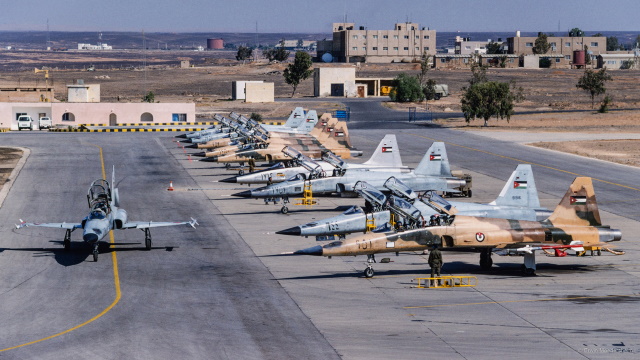 Photo: Erwin Moedersheim
Photo: Erwin Moedersheim
Mixed line up in 1998 at Prince Hassan AB; visible Northrop F-5F 951, 644 and various Northrop F-5E of 17 Squadron.
During 2008/09 another (16 former Belgian aircrafts) were
delivered; in 2011 6 General
Dynamics F-16A and 3 F-16B (Dutch) followed and again by 15
former Dutch aircrafts in 2017. They all enabled the transition of
all three
units to re-equip with the advanced fighter.
A
change of training equipment started in 2014 with the supply of 13 BAC
Hawk Mk63A for the lead-in fighter training role, replacing Tigers. The remaining Tigers
(apart two) were stored at the H5 airfield. They were
sold to a private USA company, Tactical Air Support, in
Reno. Air delivery started in 2018.
Squadrons history
King Hussein Air College
This
was established at Mafraq AB in 1974, the Flying School was its
operational center.
The Air College (name given from 1978) consisted of No.4
Squadron equipped with Scottish Aviation Bulldog Mk.125 for initial
training, No.6 Squadron with Cessna T-37B for basic training and No.2 Squadron with
Northrop F-5A/B for operational conversion training. Pilots flew ca 7 months on tactics and
weapons training before being considered operational.
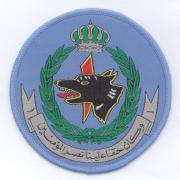
No.1 Squadron The
Freedom Fighters were pooled with No.2 Squadron; unfortunately there
have been no photos showing Squadron serials applied on
aircrafts, thus confirming the operation by
the Squadron, though the
official Royal Jordanian AF site mentions it.
Freedom Fighters were replaced by 17 GAMD Mirage F.1EJ during 1982/83, the unit moving
contemporaneously to El Azraq AB. This enabled the
sale of some aircrafts: 13 Northrop F-5A (one as
a spare parts source only, on
board an Lockheed C-130) and 6
F-5B went to Greece, transiting Larnaca (Cyprus) on 14-11-83.
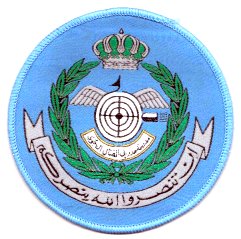
No.2 Squadron was also part of the King Hussein Air College
at Mafraq, the Air Force Training Center.
By
1983 there were 16 F-5As and 7 F-5B used for advanced training only. These could
be quickly converted to war operation in case of a crise; it kept its Freedom
Fighters till 1987, when it was
disbanded, to be reformed in 2003 with former US Air National Guard General
Dynamics F-16A-20-MLU.
Four F-5s
were put on sale in 1989, one F-5B being placed on the US civilian register in July 1990 and three F-5As following in November 1995. Another F-5B (possibly
an F-5A with crudely modified cockpit) was put on display at Mafraq AB.
The unit received CASA C.101CC from 1987 and the Freedom Fighters were withdrawn from use.

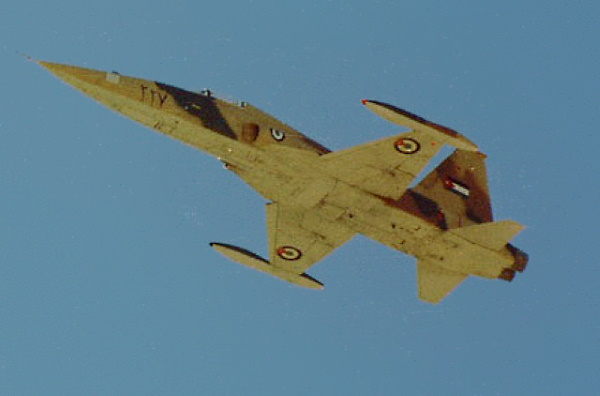 Photo: unknown
Photo: unknown
Northrop F-5A 226 photographed on 21-04-84
Photo:
Archive The Northrop F-5 Enthusiast Underfuselage view of Northrop F-5A
serial 225 taking off from Mafraq AB on 20-09-86

Northrop F-5B 233 photographed in flight late
'80s.
Photo:
via Ramez Yaghnam
No.6 Squadron
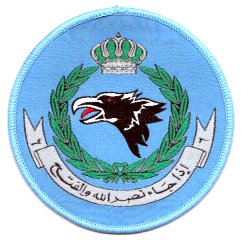
 Photo: Denis Hughes
Photo: Denis Hughes
Northrop
F-5A, serial 600/A, was photographed long before 10-95 (probably in
1975)
The
unit operated Northrop F-5A as well as Northrop F-5B. It changed its role to training with No.
11 Squadron Cessna T-37B in 1975.
The fighter role was handed over to the
newly established No. 11 Squadron; it became again a fighter unit, Northrop
F-5E/F equipped on
31-05-85, based at Azraq AB till 1988 when it was
transferred to H5/ Prince Hassan AB. Its roles were reconnaissance, air
defence and close air support.
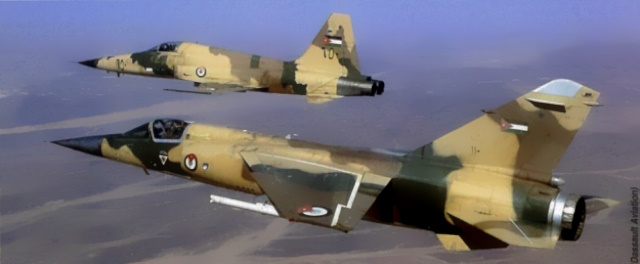
A camouflaged Northrop F-5E, serial 650, with its successor
Mirage F.1 serial 115
By 1995 its aircrafts were pooled with
No 17 Sqadron at H-5 Air Base.
It was deactivated in 2010 and reactivated in 2011 (2003?) at Muwaffaq Al Salti AB with 12 General Dynamics F-16A Block 20 MLU and 5 F-16B ex Belgian aircrafts.

Prince Hassan AB Northrop F-5EF 648 (note overpainting of nose serial from 1148) seen on 10-04-74 at Azraq
Photo: Archive The Northrop F-5
Enthusiast
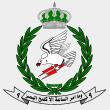 No. 9 Squadron
No. 9 Squadron
It was the second Squadron to receive Tigers, also at Prince Hassan AB, as replacement of Lockheed
F-104A/B. Its aircrafts were camouflaged,
main duty was ground was grund attack, second air defence.
Lockheed F-104 operation ended in July 1977 with the completion of
initial Northrop F-5E delivery.
The Squadron was transferred in 1992 to Jafr/King Feisal AB. By 2014 Northrop F-5 operation had also ceased, replaced by Falco and Camcopters UAVs


Northrop F-5E 936 at Azraq AB
on 10-04-74. Note big serial on
tail!
Northrop F-5F 951 at
Prince Hassan AB on 07-07-98

A second new unit, No.11
Squadron, was established with Tigers at King Faisal AB on 06-01-78 for air defence and ground attack, with camouflaged aircrafts. By 1983 it was still partially
operational.
It became a training unit equipped with Cessna T-37Bs exchanging again its Squadron number with No. 6 Squadron on 31-05-85.
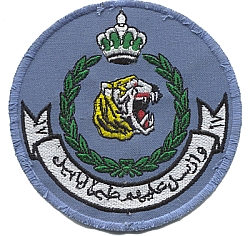 A new unit No. 17 Squadron was
established on 12-03-73 at Prince Hassan AB with Northrop F-5E and F-5F in air defence and ground attack roles.
A new unit No. 17 Squadron was
established on 12-03-73 at Prince Hassan AB with Northrop F-5E and F-5F in air defence and ground attack roles.
At least 2 F-5B were transferred to No.17 Squadron from
the Mafraq pool, later replaced by F-5Fs. By 1995 its aircrafts were pooled with No 6 Squadron at H-5 Air Base.
The unit has acted as an Operational Conversion Unit, before pilots were transferred to General Dynamics F-16s equipped units.
Thirteen BAE Hawk Mk63A for the lead-in role were donated mid/end 2014 by the United Arab Emirates, they supplanted the Northrop F-5E/F-5F in the advanced training role;
two Northrop F-5s remained to represent this fighters; they are not operational.


Northrop F-5E 1708 in metallic colours
at Al Jafr on 10-06-95
Photo:
unknown
Northrop F-5F 1752 seen on 10-04-74 at Azraq Photo: Archive
The Northrop F-5 Enthusiast
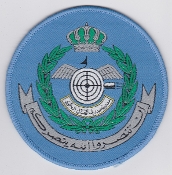
Fighter Weapons Instructor School at King Feisal AB was formed in 1981 to teach weapons use to
instructors based on the training syllabus of the USAF,
according 425th
Tactical Fighter Training Squadron, with double- and
single-seaters. The school could teach F'5s and
Mirage F.1s weapons systems, its
instructors returning to their
units as Qualified Weapons Instuctors. It has trained students from
Iraq, Egyot and Malaysia as well as of other Middle and
Far Eastern countries.
Operation/visits abroad and Squadron exchanges
US
intelligence signalised the transit of 3 Northrop F-5A with Pakistatini
insegnias at Teheran (Iran) on 26-12-71 en route from Turkey to
Pakistan with Pakistani crews. These are generally quoted as Jordanian
(or Lybian, not ptobable)
aircrafts sent to help Pakistan in the war with India, but arriving too
late to participate to the war and were returned a few months later.
Known visits
abroad are at Greenham Common (UK) on July 1981
F-5E 1151, 1161 from
No.11 Squadron and at Church Fenton (UK) air show on 13-06-83 F-5E 927,
935 from No.9 Squadron and F-5F 1751
from No.17 Squadron.
During
the Iran-Iraq 1980-1988 war Prince Hassan AB was used as a main supply
route by Iraq. The F-5s, particularly the No.9 and No.17 Squadrons
aircrafts at this base, were on continous alert, just in case the
war
would spill over to Jordan.
Rather unusual was the use in
the reconnaissance role of six
aircrafts modified with camera
equipped noses, operated
from Prince Hassan
AB.
Jordan was by
1983 practically self-sufficient in F-5 maintenance, training and operation;
a high operational readiness rate of 86% was sustained. Dissimilar
combat maneuvring training with GAMD Mirage F.1 were
carried out
regularly; J-85 engines were maintained at Mefraq AB at a local engine
maintenance facility.
Northrop
F-5F participated, together with USAF aircrafts, to the exercise "
Shadow Hawk 87" in September 1987; F-5Es were present at the 1989 edition from 29 October to 03
November together with Jordanian
GAMD Mirafe F-1s, 12 USAF Mc Donnel F-4Cs
of the 122 Tactical Fighter Wing (ANG), 6 F-16C Block 25s of the 363rd Tactical
Fighter Wing and 2 Boeing E-3s AWACS of the 552nd Air Warning and
Control Wing,
to the exercise " Shadow Hawk 90"; Jordanian aircrafts attacked the USAF aircrafts for two
days and defended Jafr AB for two days, helped by the AWACS.
Jordanian neutral attitude during the
1990-1991 first Gulf War (seen by the USA as a support to Iraq) lead to to the
freezing of
all US aid and
to spares shortages for all US
equipment, including the F-5 and C-130, forcing a reduction in
essential
training; the aid was anyhow restarted after King Hussein condemned
Iraqi invasion of Kuwait in October 1994.
An unusual happening took place on 22-10-95 in
commemoration of the peace treaty with Israel, signed exactly one year earler, when Jordanian Mirage
F.1s and F-5s met with Israeli F-15s and F-16s over the Generazeth lake
to overfly the Israelian cities of Tiberias, Haifa, Tel Aviv and
Jerusalem, followed by the Jordanian ones: Amman, Zarka and Irbid.
Foreign
participation to excercises in Jordan include Jaguar fighter-bombers of
No.6 Squadron RAF in
excercise "Desert Cat 2006" from 01 to 14-09-06 against Jordanian
F-16A/C, Mirage F.1 and F-5s based at Prince
Hassan AB providing combat
air defence patrols.
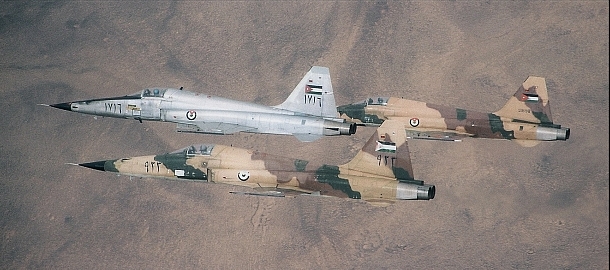
Air-to-air picture showing
aircrafts from different Squadrons in different colours/camouflages.
Note US serial on tail of
furthest aircraft. Photo:
archive the Northrop F-5 enthusiast
Upgrade/reduction of the Tiger fleet
A
deal to upgrade the systems for at least 20 aircrafts, for the value of
15m UK Pounds, was signed in 1985 with Smiths
Industries to install an Head-Up Navigation and Targeting System, Radar Warning
Receivers (RWR)
plus Head-Up Weapon Aiming Computer (HUDWAC) and BAe Laser
INS.
Plans for Forward Looking InfraRed (FLIR) were delayed. Selenia ALQ-234
ECM
pods were also bought, though not ever confirmed.
The
first upgraded Tiger flew in January 1989; initial integration problems
were overcome, but these problems were replaced with funding
difficulties.
Only a part of this programm was
actually realised due to financing problems; it is not
known exactly how many aircrafts (at least 7;
4 sold to Brazil, 3 sold to Kenya) and with which systems (HUDWAC,
RWR confirmed) it was
actually realised; the modified airframes were locally
designated F-5EM.
Reduction of the fleet was taken
into consideration in 1993 in order to equip 23 aircrafts with new
radars (APG-66T or APG-67), Radar Warning Receivers and HOTAS controls.
An
attempt to sell 4 surplus Northrop F-5E to Indonesia at a cost of USD
25m
was vetoed by the US government in June of that year due to Indonesian
human-rights
violations on Timor issue.
More luck had the sale in 1994 of 7 F-5Es to
Singapore, upgraded locally to F-5S
standard by Singapore Aerospace; this allowed to update GAMD Mirage F.1s to a later standard..
There were 55 Tiger aircrafts in service in 2004 according to an US source.
End of September 2007 the Brazilian Air Force announced
the acquisition from Jordan of 3 Northrop
F-5F, 4 Northrop F-5EM, 4 Northrop F-5E. The first three, 2 F-5E and 1 F-5F, arrived at Sao Paulo-Guarulhos
airport
on 19-08-08.
A package
sale to Kenya, comprising 10 Northrop F-5E, 3 F-5EM
and 2 F-5F, technical assistance and maintenance services,
painting of the aircrafts, installation of navigation and communication
systems, packing/deliverycand supply of spare parts as requested
and training of 16 technicians was announced in mid-2008; price
totalled USD 15.3m. In spring 2009 there were 8 Northrop F-5E and 1
F-5F parked at Amman-Marka in Kenyan camouflage but without insignia, still there by 22-09-09.
The fighter was phased-out of the led-in fighter-trainer role in 2014, replaced by 13 UAF Air Force Haker Hawk.
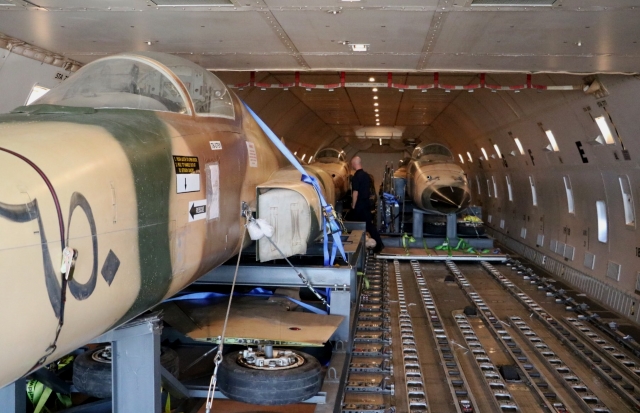
Following
deactivation of
the Tiger fleet, they were
stored in flyable coditions at H5 Air Base with hope to sell them to a
USA civilian company, TacAir. They were replaced by 13 former UAF Air
Foce and Defence Force BAE Hawk Mk.63. Officia
l approval for
the sale was given by the US State Department on 11-10-16; it regards
21 Northrop F-5E/ Northrop F-5F
and all remaining spare/ parts. They have been upgraded and are used for the support of the USAF and US Navy.
Four
Northrop F-5E have been delivered for upgrade in St Augustine via Atlas Air Boeing 747 to Orlando International
airport in February 2017, to be upgraded by Northrop. Final
destination is the company Tac Air. Two have been
photographed on 20-02-17.
Losses
Reported dates of losses,
serials not known, are as follows: frame F-5A: 20-12-78, 22-07-84; F-5B: 17-10-77, 20-12-78; F-5E
02-12-92, 21-12-92. Loss on
17-10-77 might be an F-5A; on 20-12-78 is 1 F-5A
and 1 F-5B in
flight collision. F-5 type not known:
02-08-83, 24-08-83; F-5E or F-5F:
26-03-91, 24-02-99, 19 or
21-10-03, 08-11-04, 23-05-07, 17-04-14..Losses on
02-08-83, 24-08-83 might be F-5B.


 Credit:
Roundels of the world
Credit:
Roundels of the world


 Photo: USAF
Photo: USAF 
 Photo: Erwin Moedersheim
Photo: Erwin Moedersheim


 Photo: unknown
Photo: unknown

 Photo: Denis Hughes
Photo: Denis Hughes

 No. 9 Squadron
No. 9 Squadron


 A new unit No. 17 Squadron was
established on 12-03-73 at Prince Hassan AB with Northrop F-5E and F-5F in air defence and ground attack roles.
A new unit No. 17 Squadron was
established on 12-03-73 at Prince Hassan AB with Northrop F-5E and F-5F in air defence and ground attack roles.



